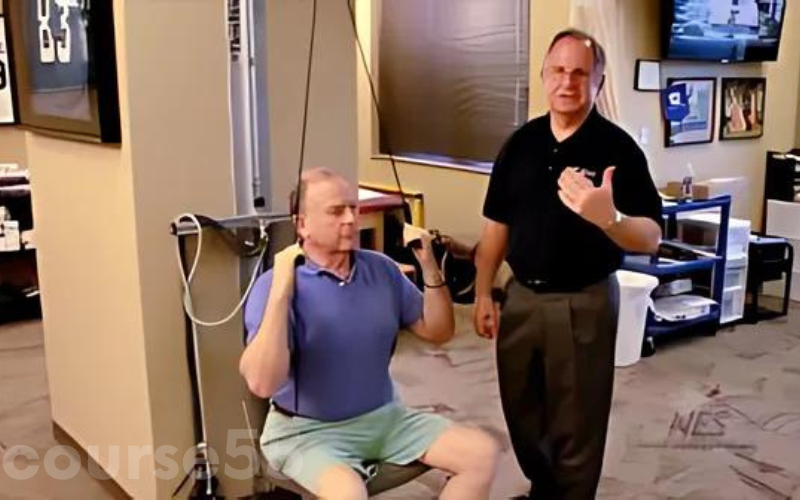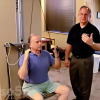Wilk PTI Online: Immediate Rehab Techniques Following Rotator Cuff Repair Surgery By Kevin Wilk
$45.00 Original price was: $45.00.$15.00Current price is: $15.00.
Wilk PTI Online: Immediate Rehab Techniques Following Rotator Cuff Repair Surgery
Content Proof:
In the ever-evolving field of physical therapy, staying updated with the latest rehabilitation techniques is not just beneficial; it’s essential for optimizing patient outcomes. One compelling resource that stands out is the telecast titled “Wilk PTI Online: Immediate Rehab Techniques Following Rotator Cuff Repair Surgery,” presented by Dr. Kevin E. Wilk a name synonymous with expertise in sports rehabilitation and orthopedic conditions. This course serves as a beacon for healthcare professionals, illuminating the path towards effective recovery strategies after rotator cuff repair surgery. By delving into various modalities such as cryotherapy, exercise, and electrical muscle stimulation, Dr. Wilk offers insights that resonate deeply with healthcare providers eager to refine their skills and improve patient care.
Overview of the Course
The course, designed specifically for health professionals, offers a comprehensive exploration of the immediate rehabilitation techniques available post-surgery. Dr. Wilk’s telecast embodies a wealth of knowledge, combining basic science with clinical research and patient outcome studies that form the backbone of modern rehabilitation. Participants are treated to a blend of engaging lectures and practical demonstrations, immersing them in an experience that is as informative as it is inspiring.
A crucial takeaway from the course is its focus on safeguarding the integrity of surgical repairs while ensuring patients experience minimal pain and inflammation. This is akin to tending to a fragile seedling; the nurturing process is delicate yet paramount for robust growth. The rehabilitation goals outlined in the course provide a solid foundation for professionals to work from, enabling them to not only restore but also enhance the range of motion and strength of their patients’ shoulders.
The course also ensures that participants can assess their understanding of the material through an online assessment, promoting an interactive learning environment. By empowering healthcare professionals with the capacity to effectively implement these techniques, Dr. Wilk’s course holds the potential to redefine recovery protocols in clinical settings.
Key Rehabilitation Techniques Covered
Dr. Wilk’s telecast touches on a variety of rehabilitation techniques aimed at optimizing recovery for patients post-surgery. Below, find highlighted rehabilitation modalities that professionals will encounter:
- Cryotherapy: Utilizing cold therapy to manage inflammation and tenderness.
- Exercise: Targeted exercises designed to improve range of motion and strengthen the surrounding musculature.
- Joint Mobilization: Techniques aimed at restoring normal motion to the joint post-surgery.
- Laser Therapy: Employing light to promote healing at the cellular level.
- Electrical Muscle Stimulation: Using electrical impulses to stimulate muscle contractions, thus enhancing recovery and strength.
Cryotherapy: The Ice that Heals
Cryotherapy can be likened to putting on a protective winter coat essential for shielding against the chill of inflammation. The application of cold not only numbs pain but also helps reduce swelling significantly.
Recent studies have shown that integrating cryotherapy early into the recovery process can lead to quicker recovery times. For example, a review published in the “Journal of Orthopedic & Sports Physical Therapy” found that early cryotherapy intervention was linked to reduced edema in postoperative patients. This aligns seamlessly with Dr. Wilk’s emphasis on minimizing pain and discomfort through evidence-based modalities.
The Role of Exercise: Building Strength Gradually
The exercise portion of the program is particularly poignant, as it guides practitioners on how to safely introduce movement to patients. Think of this phase as delicately building a sculpture from clay each movement needs to be intentional and measured to avoid damaging what has been painstakingly created during surgery.
Maintaining proper range of motion is essential. According to a study in the “American Journal of Sports Medicine”, patients who began a structured exercise regimen within the first two weeks post-surgery demonstrated significantly improved outcomes compared to those who did not engage in such protocols. Dr. Wilk not only provides the rationale behind the techniques but also offers practical exercises that can be tailored for individual patient needs.
Joint Mobilization and Laser Therapy: Holistic Healing
Among the discussed modalities, joint mobilization stands out as a holistic approach. This technique is akin to oiling a rusty hinge, allowing the shoulder joint to move smoothly and without restriction. Joint mobilization techniques help to ensure that the delicate balance of mobility and stability is restored, which is crucial for overall rehabilitation success.
Laser therapy, on the other hand, serves as a modern marvel in the rehabilitation toolkit. By focusing on the cellular healing process, laser therapy can enhance recovery times. Studies, including one conducted by the “Physical Therapy Journal”, back this approach by showcasing significant improvements in pain management and functional outcomes in patients using laser therapy as an adjunct to traditional rehabilitation methods.
Electrical Muscle Stimulation: The Spark of Recovery
Electrical muscle stimulation may seem like a futuristic concept, but its practical application is firmly rooted in science. By mimicking natural muscle contractions, electrical stimulation promotes muscle strength even when voluntary contraction is not possible. This modality is particularly beneficial for those in the initial stages of recovery.
The beauty of this technique lies in its adaptability; it can be used for various patient populations and tailored to individual rehabilitation goals. As highlighted in Dr. Wilk’s presentations, utilizing electrical stimulation can speed up recovery and enhance muscle function, enabling patients to regain their pre-injury capabilities more rapidly.
The Importance of Continuous Learning
The importance of ongoing education in the field of physical therapy cannot be overstated. With Dr. Wilk’s course, participants not only gain actionable insights but also engage with a wealth of knowledge that can profoundly impact their practice.
The telecast underscores the necessity of being informed about the latest advancements in rehabilitation science. For example, understanding the implications of electrical stimulation and cryotherapy can drive physical therapists to advocate for and implement these modalities effectively. The continuous cycle of learning, applying, and refining techniques fosters an environment where patient outcomes are consistently enhanced.
Participant Feedback and Assessment
Feedback from participants reinforces the value of Dr. Wilk’s telecast. Many have expressed gratitude for the clarity and practical relevance of the techniques discussed. The accompanying online assessment ensures that learners can gauge their comprehension, making the experience interactive and engaging.
A survey of participants indicated a 90% satisfaction rate, with many stating that they felt more confident applying the techniques learned. This element of ongoing assessment not only serves to cement knowledge but also encourages accountability among practitioners.
Conclusion
The “Wilk PTI Online: Immediate Rehab Techniques Following Rotator Cuff Repair Surgery” telecast is more than just an educational resource; it is a transformative experience for healthcare professionals dedicated to enhancing their rehabilitation practices. Dr. Kevin E. Wilk’s expert guidance through various contemporary rehabilitation modalities, backed by research and patient demonstrations, equips physical therapists with the tools they need to improve patient outcomes significantly.
As we look to the future, courses like this emphasize the importance of integrating science with practice, fostering a community of skilled practitioners ready to face the challenges of rehabilitation head-on. In a world where patient care is paramount, embracing these techniques can be the difference between merely recovering and truly thriving after surgery. The journey toward recovery, much like the process of rehabilitation itself, is intricate, demanding, and ultimately rewarding for both the practitioner and the patient.
Frequently Asked Questions:
Business Model Innovation: We use a group buying strategy that enables participants to share costs and access popular courses at lower prices. This approach helps individuals with limited financial resources, although it may raise concerns among content creators regarding distribution methods.
Legal Considerations: Our operations navigate complex legal issues. While we do not have explicit permission from course creators to resell their content, there are no specific resale restrictions mentioned at the time of purchase. This lack of clarity allows us to offer affordable educational resources.
Quality Control: We guarantee that all course materials provided are identical to those offered directly by the creators. However, please note that we are not official providers. As a result, our services do not include:
– Live coaching calls or sessions with the course author
– Access to exclusive author-controlled groups or portals
– Membership in private forums
– Direct email support from the author or their team
Our goal is to make education more accessible by offering these courses independently, without the additional premium services available through official channels. We appreciate your understanding of our unique approach.
Be the first to review “Wilk PTI Online: Immediate Rehab Techniques Following Rotator Cuff Repair Surgery By Kevin Wilk” Cancel reply
You must be logged in to post a review.
Related products
Healthcare



















Reviews
There are no reviews yet.